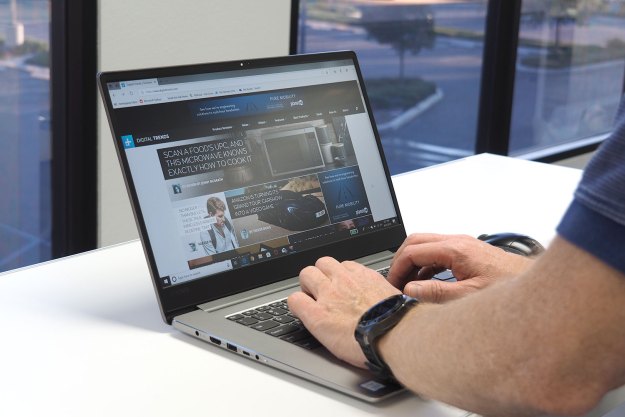
“My real objective was to get the idea across [that] we have the technology that’s going to make electronics cheap,” explained Moore in a video posted by Intel earlier this year. “But I didn’t expect this binary order of magnitude increase — the thousand-fold increase in complexity — to be very accurate.”
IBM built a 7nm chip last week, putting Intel behind the curve for the first time in years.
Moore, now 86, never expected his axiom to catch on with tech companies to the degree that it did. But, to be clear, Moore’s Law isn’t a law at all, because it doesn’t technically govern or dictate. Moore’s Law was an observation of trends — and a prediction of what might be possible.
Intel has become the shining beacon of processor research and production, particularly in the consumer space. It has continually broken ground on smaller production nodes, and it currently owns four fabrication facilities capable of working on the cutting-edge 14 nano-meter process. The closest competitors, Samsung and Global Foundries, have just one each, and the latter company’s fab facility reached “volume production” capability just a few months ago.
Now, however, even Intel is having trouble with smaller, more advanced production. Its 10nm process has been “indefinitely” delayed, and a new 14nm design has been stuck in its place — a rare event. Does Intel’s struggle indicate a broader issue, and the possible end of Moore’s Law?
“Ticked” off by delays
As Bob Dylan once famously declared, the times they are a-changin’, an utterance not limited to Moore’s Law, which has undergone numerous alterations over the years, but one thing remains consistent. That is, the number of transistors in an integrated circuit generally doubles over a set period of time. Thanks to former Intel executive David House, 18 months has served as the magic number since 1975.
Nowadays, Intel is unquestionably the world’s most successful chip maker, but the cancellation of the 10nm process raises concern. IBM built a 7nm chip last week, putting Intel behind the curve for the first time in years. As it turns out, radically advancing technology is often paired with equally profound challenges.
What was once perceived as the law of the land may have finally met its match. In the case of Intel, the complications started back in 2013 when its 14nm Broadwell chips were delayed until early 2014. Intel CEO Brian Krzanich blamed a “defect density issue,” which directly impacted chip production. Put simply, too many chips were leaving the line with problems.
The delay was not only significant due to its impact on Moore’s Law, but the move negatively affected Intel’s “tick-tock” model, which has been in place for the company since 2007. Tick-tock takes the fundamental principle of Moore’s Law and integrates it into a series of procedural cycles. Each “tick” aims to introduce a new shrinking of the previous architecture’s process technology while every “tock” brings forth a new micro-architecture design. Intel has held true to this cadence since 2007 without difficulty. The sudden stumble is curious.
Skipping a beat
While Broadwell’s chips were technically available in late 2014, the initial roll-out only targeted low-power laptops. Even then, the pickings were slim. Now Broadwell is finally making its way to consumers and businesses alike, albeit only months before the launch of Intel’s next micro-architecture redesign, or “tock” as Intel would insist.
Intel’s tick-tock cadence could be headed towards extinction.
That tock is Skylake, better known as 6th-generation Core, and it will be out sometime in August or September, as scheduled. What should follow is a “tick” to a 10nm processor, which planned, and code-named Cannon Lake. It is now delayed.
Therefore, the next scheduled tick in its corporate roadmap will be interrupted by yet another tock. That tock is Kaby Lake, the successor to Skylake and Intel’s third micro-architecture in a row to feature a 14nm manufacturing process, a consequence of the company’s failure to fully realize its next-generation die shrink technology.
The mere existence of Kaby Lake indicates the “Tick-Tock” could be headed towards extinction, undeterred by Krzanich’s utter denial on the matter. In a recent earnings call, however, the Intel CEO did admit that “the last two technology transitions have signaled that our cadence today is closer to 2.5 years than two,” according to The Verge.
Reputation Reparations
Intel’s recent behavior appears to signify the beginning of the end for the historically effective observations of Gordon Moore. And, from there, the speculation only gets worse. Following the launch of Cannonlake and its presumably 10nm successor, Intel’s next microarchitecture shrink is scheduled to feature a 7nm chip processing technology. However, in doing so, Intel has acknowledged that the use of new materials will be required — which could very well cause even greater delays.
Moore’s Law might not die if there was another company that could pick up Intel’s slack — but there isn’t. IBM has managed to produce a 7nm chip in the lab, but it has no capability to market such a chip to consumer electronics. It is working with two major partners, Samsung and Global Foundries, towards that end. But IBM says the process won’t actually be ready for serious production until 2017 or 2018, at the earliest.

And while both those partners are major players in the chip industry, neither has the production capacity to rival Intel’s broad product roll-outs. Even if IBM’s breakthrough encounters no delays, which is unlikely, we’ll see 7nm chips debut only in a small number of premium devices, like Samsung Galaxy smartphones. Moore’s Law has been important not only because companies manage to achieve impressive cadence, but also because the resulting chips showed up in computers quickly, something made possible by Intel’s mass of fabrication facilities.
Moore’s Law was never intended to last forever, and it seems now that we’re beginning to see why. Not only is this a sign of the world’s Intel’s inability to keep up, but when the world’s biggest chip company is incessantly suffering from manufacturing issues, consumers see the consequences. If a rising tide lifts all ships, then the reverse is also true — and it appears the tide is going out.



